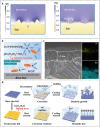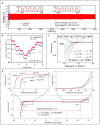Solid Electrolyte Interface in Zn-Based Battery Systems
- PMID: 36261666
- PMCID: PMC9582111
- DOI: 10.1007/s40820-022-00939-w
Solid Electrolyte Interface in Zn-Based Battery Systems
Abstract
Due to its high theoretical capacity (820 mAh g-1), low standard electrode potential (- 0.76 V vs. SHE), excellent stability in aqueous solutions, low cost, environmental friendliness and intrinsically high safety, zinc (Zn)-based batteries have attracted much attention in developing new energy storage devices. In Zn battery system, the battery performance is significantly affected by the solid electrolyte interface (SEI), which is controlled by electrode and electrolyte, and attracts dendrite growth, electrochemical stability window range, metallic Zn anode corrosion and passivation, and electrolyte mutations. Therefore, the design of SEI is decisive for the overall performance of Zn battery systems. This paper summarizes the formation mechanism, the types and characteristics, and the characterization techniques associated with SEI. Meanwhile, we analyze the influence of SEI on battery performance, and put forward the design strategies of SEI. Finally, the future research of SEI in Zn battery system is prospected to seize the nature of SEI, improve the battery performance and promote the large-scale application.
Keywords: Artificial SEI; In situ SEI; Solid electrolyte interface; Solvated structure; Zn-based battery.
© 2022. The Author(s).
Figures









References
-
- Oh P, Lee H, Park S, Cha H, Kim J, et al. Improvements to the overpotential of all-solid-state lithium-ion batteries during the past ten years. Adv. Energy Mater. 2020;10(24):2000904. doi: 10.1002/aenm.202000904. - DOI
-
- Yang XG, Liu T, Wang CY. Thermally modulated lithium iron phosphate batteries for mass-market electric vehicles. Nat. Energy. 2021;6(2):176–185. doi: 10.1038/s41560-020-00757-7. - DOI
-
- Zeng XQ, Li M, El-Hady DA, Alshitari W, Al-Bogami AS, et al. Commercialization of lithium battery technologies for electric vehicles. Adv. Energy Mater. 2019;9(27):1900161. doi: 10.1002/aenm.201900161. - DOI
Publication types
LinkOut - more resources
Full Text Sources
